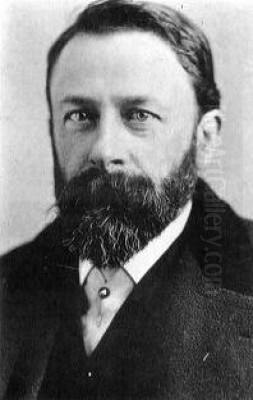
Albert Bierstadt stands as one of the towering figures of nineteenth-century American art. A German immigrant who embraced his adopted homeland, he became renowned for his breathtaking, large-scale depictions of the American West. Associated with the later generation of the Hudson River School and the Luminist movement, Bierstadt captured the grandeur, majesty, and often romanticized wilderness of a nation expanding its frontiers. His works, characterized by meticulous detail, dramatic lighting, and vast perspectives, not only achieved immense popularity during his lifetime but also played a significant role in shaping the visual identity of the American landscape in the public imagination.
Early Life and American Beginnings
Albert Bierstadt was born on January 7, 1830, in Solingen, Prussia (now Germany). His family's roots were in the Rhineland, an area known for its picturesque landscapes, which perhaps subtly influenced his later artistic inclinations. However, his formative years were spent not in Germany, but in the United States. In 1833, when Albert was just a toddler, his parents, Henry and Christiana Bierstadt, emigrated, settling in the bustling whaling port of New Bedford, Massachusetts. This coastal town, with its maritime atmosphere and diverse population, provided the backdrop for his childhood and adolescence.
Details about Bierstadt's earliest formal education are scarce, but it appears his artistic talents emerged early. By his late teens and early twenties, he was already demonstrating a proficiency in drawing and painting. Largely self-taught in these initial stages, he began offering drawing lessons in New Bedford around 1850 to support himself. This early period suggests an innate drive and a developing eye for detail, even before he received formal academic training. New Bedford, while not a major art center like New York or Boston, provided him with opportunities to observe nature and likely exposed him to marine paintings and prints common in port cities.
European Training and Influences
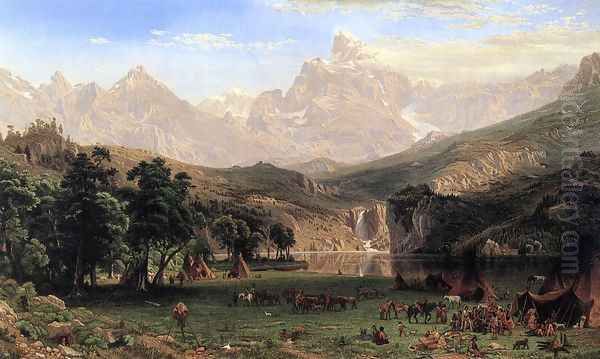
Recognizing the need for formal instruction to advance his artistic career, Bierstadt made the pivotal decision to return to his birth country for training. In 1853, at the age of 23, he traveled to Düsseldorf, Germany, a major center for academic art education at the time. He hoped to study with Johann Peter Hasenclever, a relative and noted genre painter, but Hasenclever unfortunately died shortly before Bierstadt's arrival. Undeterred, Bierstadt enrolled or at least became closely associated with the renowned Düsseldorf Academy (Kunstakademie Düsseldorf).
The Düsseldorf Academy was known for its rigorous training methods, emphasizing precise draftsmanship, detailed finish, and often narrative or historical subjects. Key figures associated with the school included Friedrich Wilhelm Schadow, Andreas Achenbach, and Carl Friedrich Lessing. Bierstadt absorbed the technical precision and detailed approach favored by the Academy, although he primarily focused on landscape painting. During his time in Düsseldorf, he formed important connections with other American artists studying there, including Worthington Whittredge and Emanuel Leutze, the latter famous for his monumental Washington Crossing the Delaware.
Bierstadt did not remain solely in Düsseldorf. He spent nearly four years traveling and painting in Germany, Switzerland, and Italy. Accompanied at times by fellow artists like Whittredge, Sanford Robinson Gifford, and William Stanley Haseltine, he sketched the Alps, the Roman Campagna, and other picturesque European landscapes. These travels were crucial, allowing him to study diverse terrains and atmospheric effects firsthand. He honed his skills in capturing mountainous scenery and dramatic light, elements that would become hallmarks of his later Western paintings. His European works, such as scenes of Lake Lucerne or the Italian countryside, demonstrate his growing mastery of technique and composition, influenced by both the Düsseldorf style and the broader European landscape tradition. Some sources also suggest influence from the landscape painter Louis Gurlitt during his time in Germany.
The Call of the American West
Returning to New Bedford in 1857, Bierstadt brought back a refined technique and a European sensibility. He quickly established a studio and began exhibiting his European scenes. However, the defining moment of his career came in 1859 when he joined a government survey expedition heading west. Led by Colonel Frederick W. Lander, the expedition was tasked with mapping an overland wagon route to the Pacific. This journey provided Bierstadt with his first encounter with the staggering landscapes of the American frontier.

Traveling through Nebraska territory towards the Wind River Range in the Rocky Mountains, Bierstadt was overwhelmed by the scale and beauty of the scenery. He made numerous sketches, oil studies painted outdoors (en plein air), and took stereoscopic photographs, documenting the mountains, plains, and Native American life he encountered. This direct observation was crucial; the sketches and photos would serve as invaluable source material for the large-scale studio paintings that would make him famous. The raw, untamed nature of the West offered a subject matter far grander and more dramatic than anything he had seen in Europe or the eastern United States.
This initial trip ignited a lifelong fascination with the West. Bierstadt made several subsequent journeys. In 1863, he traveled overland again, this time reaching California and the Pacific coast, accompanied by the writer and journalist Fitz Hugh Ludlow. This trip exposed him to the dramatic landscapes of Yosemite Valley and the Sierra Nevada mountains, which would become recurring subjects in his work. Later trips took him back to California, the Rockies, and even Alaska (then Russian America) and the Canadian Rockies. Each expedition provided fresh inspiration and reinforced his reputation as the preeminent painter of the American West.
Master of Light and Landscape: Technique and Style
Albert Bierstadt's artistic style is characterized by a unique blend of meticulous realism and heightened romantic drama. He worked primarily in oils, often on exceptionally large canvases, earning them the moniker "Great Pictures." These monumental works were intended to immerse the viewer in the scene, conveying the sublime power and scale of the American wilderness. His technique, honed in Düsseldorf, involved careful underdrawing and the layering of thin glazes of paint to achieve fine detail and luminous effects.
A key element of Bierstadt's style is his masterful handling of light and atmosphere. He is often associated with Luminism, a mid-19th-century American art movement characterized by its focus on subtle light effects, serene moods, and concealed brushwork. Artists like Fitz Henry Lane, Martin Johnson Heade, and Sanford Robinson Gifford were also key figures in Luminism. Bierstadt employed dramatic contrasts of light and shadow, often highlighting specific areas of the landscape with shafts of sunlight breaking through clouds or illuminating mountain peaks. He excelled at depicting atmospheric conditions – mist rising from valleys, storm clouds gathering over mountains, the hazy glow of sunset – which added emotional depth and theatricality to his scenes.
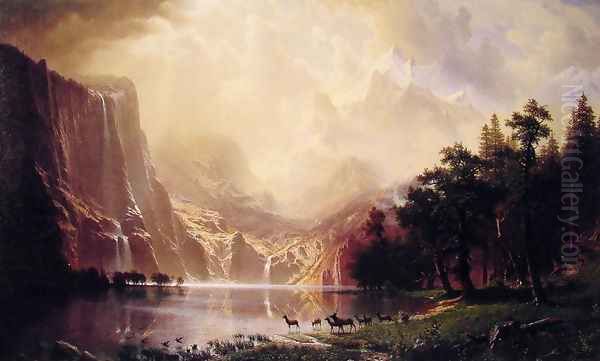
While grounded in detailed observation from his field sketches, Bierstadt's studio paintings were not strictly topographical representations. He often composed his scenes by combining elements from different locations or exaggerating features to enhance the dramatic impact. This practice, common among landscape painters of the era including his contemporary Frederic Edwin Church, aimed to capture the essence and emotional resonance of the landscape rather than providing a literal transcription. His compositions typically feature a detailed foreground leading the viewer's eye into a vast, panoramic middle ground and background, emphasizing the immense scale of nature compared to any human or animal figures present.
Iconic Canvases: Major Works
Bierstadt's prolific output includes hundreds of paintings, but several stand out as defining masterpieces that cemented his reputation. The Rocky Mountains, Lander's Peak (1863), based on sketches from his first Western trip, was a sensational success upon its exhibition. Measuring roughly six by ten feet, it presents a panoramic view of a Native American encampment in a sunlit valley nestled beneath towering, snow-capped peaks, embodying the romantic vision of a pristine Western Eden.
His travels to California inspired equally famous works. Looking Down Yosemite Valley, California (1865) captures the iconic view of the valley, emphasizing its sheer granite cliffs and ethereal light. Among the Sierra Nevada Mountains, California (1868) is another monumental canvas, showcasing a tranquil mountain lake reflecting jagged peaks under a dramatic sky, bathed in a golden, almost divine light. These paintings presented California as a promised land of natural wonders.
Bierstadt was also drawn to the more turbulent aspects of nature. Storm in the Rocky Mountains, Mt. Rosalie (1866) is a powerful depiction of a dramatic thunderstorm breaking over the peaks, showcasing his ability to capture the sublime power and fury of the elements. Later in his career, facing a changing West and the near extinction of the bison, he painted The Last of the Buffalo (circa 1888). This large, somewhat darker work reflects on the vanishing wilderness and the tragic fate of the bison, marking a shift from his earlier, more optimistic visions. His European scenes, like various versions of Lake Lucerne, while less famous, demonstrate his consistent skill in rendering water, mountains, and atmospheric light across different geographical settings.
Fame, Fortune, and International Acclaim
The 1860s and 1870s marked the zenith of Bierstadt's fame and fortune. His large Western landscapes captivated the public and critics alike, tapping into the national fascination with westward expansion and the concept of Manifest Destiny. His paintings commanded unprecedented prices for an American artist; The Rocky Mountains, Lander's Peak reportedly sold for $25,000 in the 1860s, an enormous sum at the time. He was elected a full member of the prestigious National Academy of Design in New York in 1860.
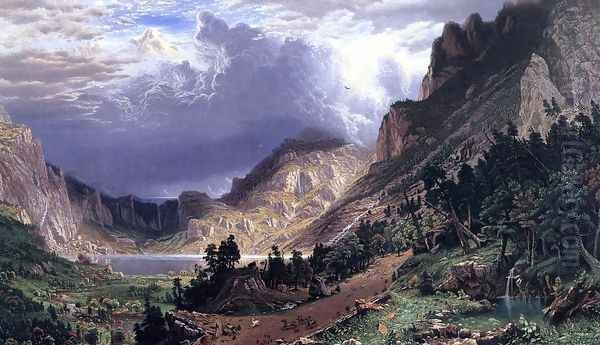
Bierstadt was not only successful domestically but also achieved significant international recognition. He exhibited his works in London and Paris, receiving medals and honors. His paintings were admired by European audiences, including royalty. Queen Victoria was said to have expressed interest, and he reportedly sold works to figures like Napoleon III of France and prominent collectors across Europe. This international acclaim further boosted his status back home.
His success allowed him to live lavishly. In 1866, he built a magnificent thirty-five-room mansion and studio overlooking the Hudson River in Irvington, New York. He named it "Malkasten" after the artists' association he had belonged to in Düsseldorf. This opulent residence, filled with his art, European furnishings, and eclectic collections (including Native American artifacts, animal specimens, and historical objects), became a symbol of his artistic triumph and a hub for socializing with patrons and fellow artists. He was, for a time, one of the most celebrated and financially successful artists in America.
Shifting Tastes: Criticism and Decline
Despite his immense popularity, Bierstadt's work was not without its critics, and his star began to fade in the later nineteenth century. Some critics found his monumental canvases overly theatrical and melodramatic, arguing that his dramatic lighting and compositional choices sacrificed topographical accuracy for sensational effect. The sheer size of his paintings was sometimes seen as ostentatious or self-aggrandizing. His romanticized depictions of Native Americans, while sometimes sympathetic, were also criticized for presenting a stereotyped or idealized view that ignored the harsh realities of their displacement.
Furthermore, artistic tastes were changing. The influence of the French Barbizon School, with its emphasis on more intimate, tonal landscapes, and the rise of Impressionism, with its focus on capturing fleeting moments and subjective perceptions of light and color, made Bierstadt's detailed, highly finished style seem increasingly old-fashioned to some segments of the art world. Artists like George Inness, influenced by Barbizon painters like Jean-Baptiste-Camille Corot and Théodore Rousseau, gained prominence with their more atmospheric and less grandiose scenes.

Personal setbacks also contributed to his decline. In 1882, his beloved studio-mansion Malkasten was destroyed by fire, resulting in the loss of numerous paintings and sketches. While he rebuilt, the loss was significant. His wife, Rosalie, suffered from tuberculosis for many years, requiring frequent travel to warmer climates, which likely impacted his productivity and engagement with the New York art scene. By the 1890s, his work was falling out of favor with major patrons and institutions. In 1889, the American selection committee rejected The Last of the Buffalo for inclusion in the Exposition Universelle in Paris, a significant blow. Financial difficulties mounted, and in 1895, Bierstadt declared bankruptcy.
Later Years and Personal Life
The later decades of Bierstadt's life were marked by these changing fortunes but also by continued artistic activity and personal adjustments. His first wife, Rosalie Osborne Ludlow (whom he married in 1866, the former wife of his traveling companion Fitz Hugh Ludlow), battled tuberculosis for years. They spent considerable time in Nassau, Bahamas, and warmer parts of the United States seeking healthier climes. Rosalie passed away in 1893. The following year, Bierstadt married Mary Hicks Stewart, a wealthy widow.
Despite his declining fame and financial struggles, Bierstadt continued to paint, producing smaller works and accepting commissions when available. He remained fascinated by technology and innovation, even securing patents for inventions related to railway car improvements. His interest in photography, evident from his early use of stereoviews, continued, reflecting a broader engagement with the visual technologies of his time. He collaborated with photographers like Peter Fales and Carleton Watkins, whose images sometimes informed his paintings.
His extensive travels continued, not just for health reasons but also driven by his enduring love of landscape. He revisited familiar locations in the West and explored new ones. His collecting habits also persisted, filling his homes with a diverse array of objects gathered from his travels and interests. Albert Bierstadt died relatively suddenly in New York City on February 18, 1902, at the age of 72. At the time of his death, his work was largely overlooked by the mainstream art world.
Enduring Legacy and Collections
For much of the early twentieth century, Albert Bierstadt's reputation remained in eclipse. However, a resurgence of interest began in the mid-to-late twentieth century, fueled by renewed appreciation for nineteenth-century American art, growing environmental awareness, and a scholarly reassessment of the Hudson River School and Luminism. Today, he is recognized as a major figure in American art history, whose work offers profound insights into the nation's nineteenth-century identity, its relationship with nature, and its westward expansion.
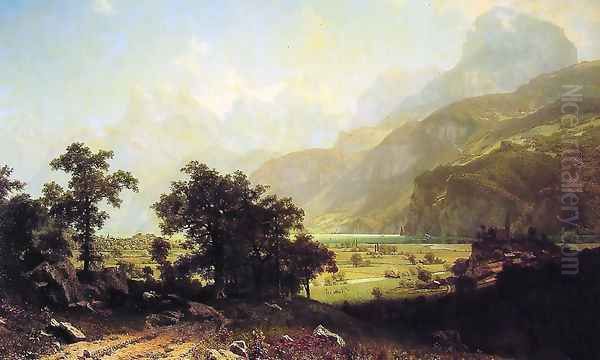
His legacy is complex. While celebrated for capturing the sublime beauty of the American landscape, his work is also analyzed in the context of Manifest Destiny and the often-destructive impact of westward expansion on Native American cultures and the environment. His paintings, once seen as straightforward celebrations of nature, are now often interpreted through lenses of cultural history, environmentalism, and post-colonial critique. Regardless of interpretation, the visual power and technical brilliance of his best works remain undeniable.
Bierstadt's paintings are held in the collections of virtually every major American art museum, including the Metropolitan Museum of Art in New York, the National Gallery of Art in Washington, D.C., the Museum of Fine Arts, Boston, the Amon Carter Museum of American Art in Fort Worth, the Gilcrease Museum in Tulsa, and the Brooklyn Museum. Significant works are also found in the collections of the US Capitol Building in Washington D.C. His European works and studies can be found in institutions like the Victoria and Albert Museum and the British Museum in London, and the Kunsthistorisches Museum in Vienna. His enduring connection to the landscapes he painted is memorialized by Mount Bierstadt, a prominent peak in the Colorado Rockies named in his honor.
Conclusion
Albert Bierstadt's journey from Solingen, Germany, to the forefront of the American art world is a remarkable story. As a key member of the Hudson River School's later phase and a master of Luminist effects, he translated the monumental landscapes of the American West onto vast canvases with unparalleled technical skill and dramatic flair. His paintings captured the imagination of a nation, defining the visual iconography of the Rockies, Yosemite, and the western frontier for generations. Though his fame fluctuated with changing artistic tastes and historical perspectives, his work endures. Bierstadt remains a pivotal figure, whose art continues to evoke the awe-inspiring beauty and complex history of the American landscape, prompting reflection on nature, nationhood, and the enduring power of the sublime. His contemporaries included giants like Frederic Edwin Church, Thomas Moran, Thomas Cole, Asher B. Durand, Sanford Robinson Gifford, Worthington Whittredge, Emanuel Leutze, George Inness, and Winslow Homer, placing him firmly within a rich and dynamic period of American artistic creation.